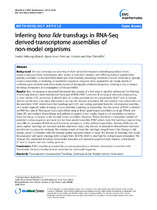| dc.contributor.author | Mbandi, Stanley K. | |
| dc.contributor.author | Hesse, Uljana | |
| dc.contributor.author | Van Heusden, Peter | |
| dc.contributor.author | Christoffels, Alan | |
| dc.date.accessioned | 2015-06-03T08:13:10Z | |
| dc.date.available | 2015-06-03T08:13:10Z | |
| dc.date.issued | 2015 | |
| dc.identifier.citation | Mbandi, S.K. et al. (2015). Inferring bona fide transfrags in RNA-Seq derived-transcriptome assemblies of non-model organisms. BMC Bioinformatics, 16:58 | |
| dc.identifier.uri | http://hdl.handle.net/10566/1491 | |
| dc.description.abstract | Background: De novo transcriptome assembly of short transcribed fragments (transfrags) produced from sequencing-by-synthesis technologies often results in redundant datasets with differing levels of unassembled, partially assembled or mis-assembled transcripts. Post-assembly processing intended to reduce redundancy typically involves reassembly or clustering of assembled sequences. However, these approaches are mostly based on common word heuristics and often create clusters of biologically unrelated sequences, resulting in loss of unique
transfrags annotations and propagation of mis-assemblies.
Results: Here, we propose a structured framework that consists of a few steps in pipeline architecture for Inferring Functionally Relevant Assembly-derived Transcripts (IFRAT). IFRAT combines 1) removal of identical subsequences,
2) error tolerant CDS prediction, 3) identification of coding potential, and 4) complements BLAST with a multiple domain architecture annotation that reduces non-specific domain annotation. We demonstrate that independent of the assembler, IFRAT selects bona fide transfrags (with CDS and coding potential) from the transcriptome assembly of a model organism without relying on post-assembly clustering or reassembly. The robustness of IFRAT is inferred on RNA-Seq data of Neurospora crassa assembled using de Bruijn graph-based assemblers, in single (Trinity and Oases-25) and multiple (Oases-Merge and additive or pooled) k-mer modes. Single k-mer assemblies contained fewer transfrags compared to the multiple k-mer assemblies. However, Trinity identified a comparable number of
predicted coding sequence and gene loci to Oases pooled assembly. IFRAT selects bona fide transfrags representing over 94% of cumulative BLAST-derived functional annotations of the unfiltered assemblies. Between 4-6% are lost when orphan transfrags are excluded and this represents only a tiny fraction of annotation derived from functional transference by sequence similarity. The median length of bona fide transfrags ranged from 1.5kb (Trinity) to 2kb (Oases), which is consistent with the average coding sequence length in fungi. The fraction of transfrags that could be associated with gene ontology terms ranged from 33-50%, which is also high for domain based annotation. We showed that unselected transfrags were mostly truncated and represent sequences from intronic, untranslated
(5′ and 3′) regions and non-coding gene loci.
Conclusions: IFRAT simplifies post-assembly processing providing a reference transcriptome enriched with functionally relevant assembly-derived transcripts for non-model organism. | en_US |
| dc.description.sponsorship | Department of Science and Technology
National Research Foundation
South African Research Chair initiative | en_US |
| dc.language.iso | en | en_US |
| dc.publisher | BioMed Central | |
| dc.rights | © 2015 Mbandi et al.; licensee BioMed Central. This is an Open Access article distributed under the terms of the Creative Commons Attribution License (http://creativecommons.org/licenses/by/4.0), which permits unrestricted use, distribution, and reproduction in any medium, provided the original work is properly credited. The Creative Commons Public Domain Dedication waiver http://creativecommons.org/publicdomain/zero/1.0/) applies to the data made available in this article,
unless otherwise stated. | |
| dc.source.uri | http://dx.doi.org/10.1186/s12859-015-0492-5 | |
| dc.subject | Transfrags | en_US |
| dc.subject | De novo transcriptome | |
| dc.subject | Transcriptome reconstruction | |
| dc.title | Inferring bona fide transfrags in RNA-Seq derived-transcriptome assemblies of non-model organisms | |
| dc.type | Article | en_US |
| dc.privacy.showsubmitter | false | |
| dc.status.ispeerreviewed | true | |
| dc.description.accreditation | Web of Science | |

